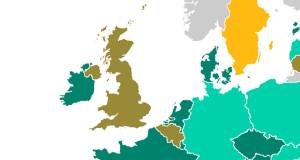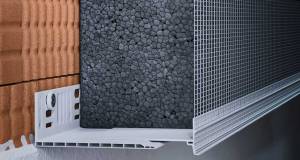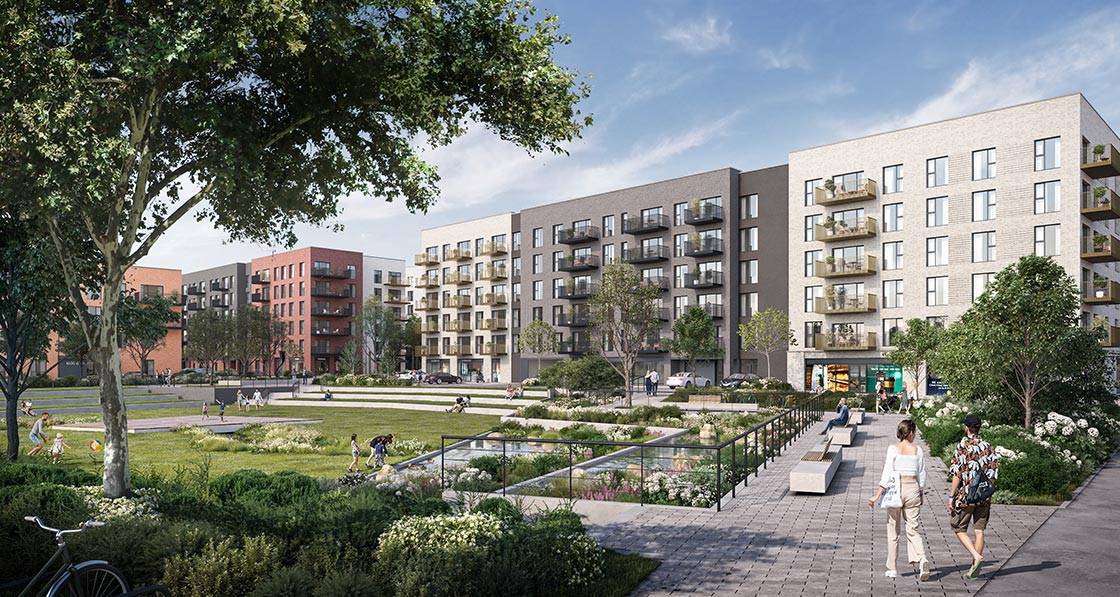
- Feature
- Posted
Passive breakthrough
In September Cairn Homes lit the fuse on a passive house explosion, publishing a position paper on passive house and announcing the construction of nearly 1,800 apartments to the standard. But what’s behind the company’s bold move?
This article was originally published in issue 48 of Passive House Plus magazine. Want immediate access to all back issues and exclusive extra content? Click here to subscribe for as little as €15, or click here to receive the next issue free of charge
In The Devil’s Dictionary, Ambrose Bierce defined the corporation as “An ingenious device for obtaining individual profit without individual responsibility.” Though Bierce’s masterwork dates back to 1906, these words could have been written yesterday. For more than a hundred years the perception has endured: Big Business Does Bad Things.
So what on earth, you might quite reasonably ask, is Ireland’s largest house builder, Cairn Homes PLC, doing building over 1,750 certified passive houses, with a further 1,250 in the pipeline for next year?
And it gets worse. It’s not just passive houses. It’s passive social and affordable housing, which is also aiming to integrate several other aspects of sustainability via using the Irish Green Building Council’s Home Performance Index (HPI), on sites which are aiming for biodiversity net gain, with sustainable transport options. It begs the question: who are we supposed to rail against, if house builders start acting like this?
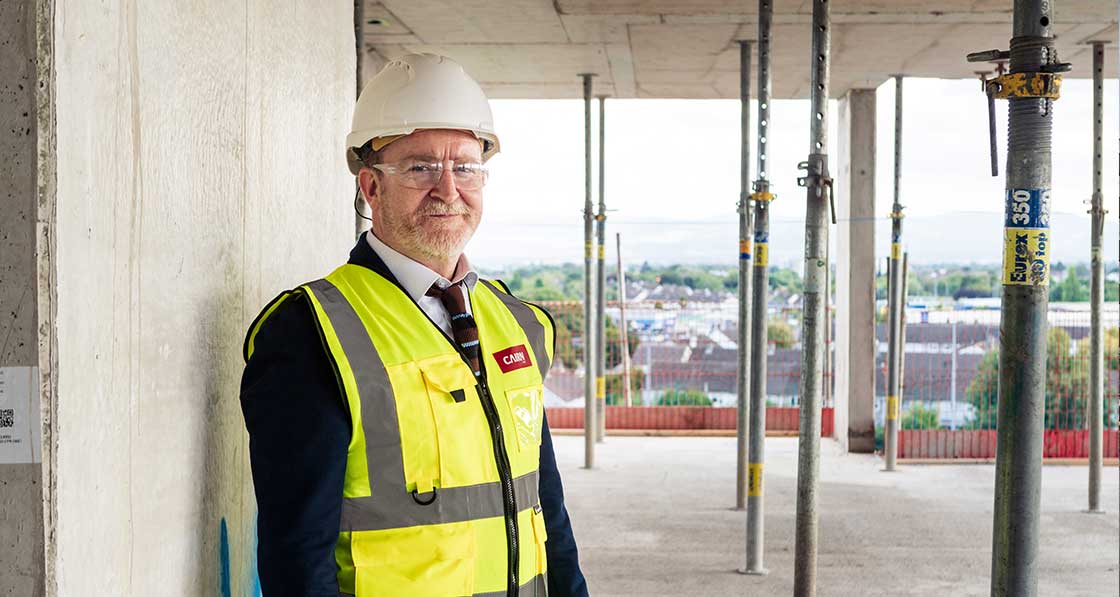
Cairn's head of sustainable construction and reporting, Stephen O'Shea, on a site visit to Pipers Square
Cairn’s passive house rollout is breathtaking in its speed and scale, with four large apartment schemes being built simultaneously around Dublin. The first two, Pipers Square in Charlestown, and Cooper Square in Seven Mills, are slated to have the first units ready to occupy (RTO) by the end of 2025, totalling 590 and 607 units each. Two smaller projects in Santry – 255 units at Whitehaven and 303 units at Niven Oaks – are due to have first units RTO by the end of 2025 and April 2026 respectively, with all four schemes set for final completion in the first half of 2026. This totals 1,755 units on site, all targeting passive house certification.
What’s more in the midst of implementing this change Cairn pulled together a position paper on passive house – which, full disclosure, I had the pleasure of co-authoring via my new communications consultancy, Zero Ambitions Partners – to explain why Cairn were throwing their considerable weight behind passive house, what benefits it would bring for everyone from residents to building owners to construction workers, and in the process reassure their clients that they hadn’t lost the run of themselves.
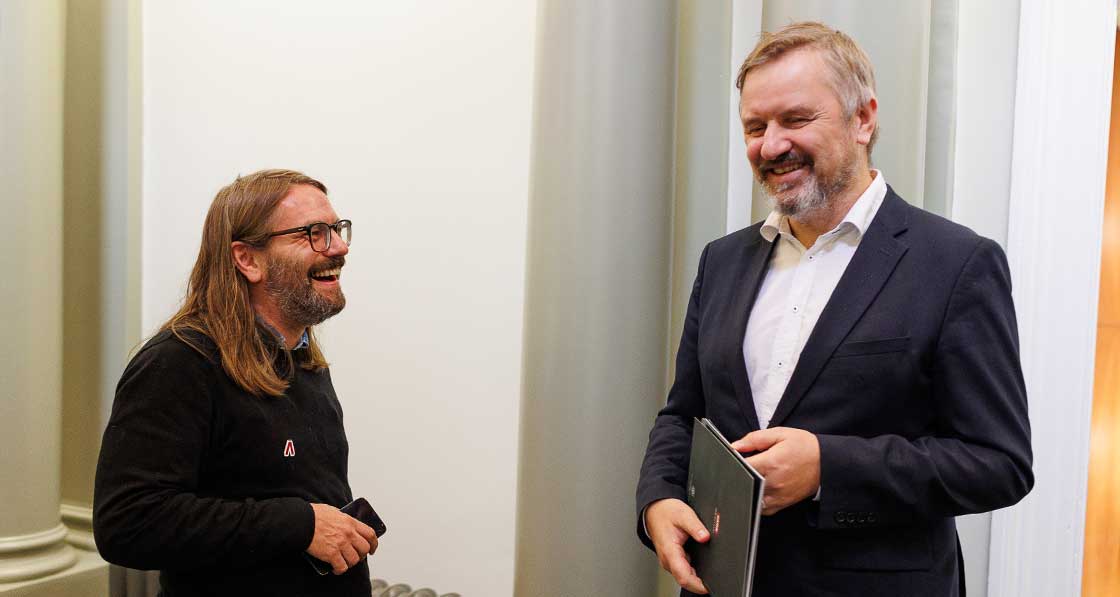
The seeds of Cairn's passive house plans were planted in a call during Covid lockdown between Cairn's creative manager Donal Thornton and Jeff Colley
The anatomy of a transition
How did Cairn’s decision to go passive come to pass? The answer, in part, starts with a positive-sense single-stranded RNA virus: SARS‑CoV‑2.
Cairn’s passive journey began during Covid lockdown in 2020. And though it is hard for me to process, Passive House Plus had a part to play in it. Cairn’s senior creative manager, Donal Thornton, rang me up out of the blue in October 2020, asking about the passive house standard, and evidently keen to learn what the company could do to improve the sustainability of its projects. I remember being startled – pleasantly – that such a big housebuilder was asking these kinds of questions, and having a characteristically long and sprawling conversation on passive house and some quick wins Cairn could implement to specify low carbon building materials. Donal contributed to a presentation on the benefits that passive house could bring at Cairn’s Innovation Forum, and the seeds were sown. And then it went quiet. In January 2022 Stephen O’Shea, an architect with twenty five years of private practice under his belt, joined Cairn – first as design manager, before becoming the head of sustainable construction and reporting in 2023.
By his own admission O’Shea had been “quite sceptical” about passive house for many years, before the opportunity to probe the standard arose when he sat the post graduate course in building performance (energy efficiency in design) at TU Dublin. “I came to respect its rigour, but it seemed very far removed from the cut and thrust of ‘normal’ building projects,” he says. “Then when I came to Cairn and learned about their attitude towards efficiency in their operations, their methods, processes and products, their passion for sustainability, and their focus on the customer journey I realised that there was the potential for a meeting of minds."

Rendering of Niven Oaks
O’Shea commissioned feasibility studies on passive house for low density and high density schemes from seasoned passive house experts MosArt, drawing on the Wicklow company’s 20 years of experience in passive house consultancy, certification and training throughout Ireland, the UK and North America on projects of all shapes and sizes.
“We’re not new to big projects,” says MosArt MD Tomás O’Leary. The firm’s high density passive track record includes the likes of a 26-storey skyscraper for Cornell Tech in New York in 2016, and a current project that’s set to dwarf it not once, not twice, but three times: Urbanest’s 2 Trafalgar Way in London’s Canary Wharf, with three towers coming in at 28, 36 and 46 storeys each.
If there’s one thing passive house enthusiasts love it’s a graph, and a graph of Irish residential passive house projects involving MosArt outlines the Irish passive house story in stark terms, ironically evoking the infamous hockey stick graphs showing the rapid growth in recent and projected future warming arising from climate change. From 2004 to 2020, the line was pancake flat, except for a couple of bumps in 2008 with UCD’s Roebuck Castle student halls and in 2017 with Durkan Residential’s 59-unit Silken Park housing scheme. The figures started to tick up from 2021-2023, with projects like Fraser Millar’s 219 homes at Lancaster Park in Belfast and Durkan Residential’s 47-unit Egremont scheme in Killiney, before a near vertical rise in 2024, with almost 2,500 units on site this year.
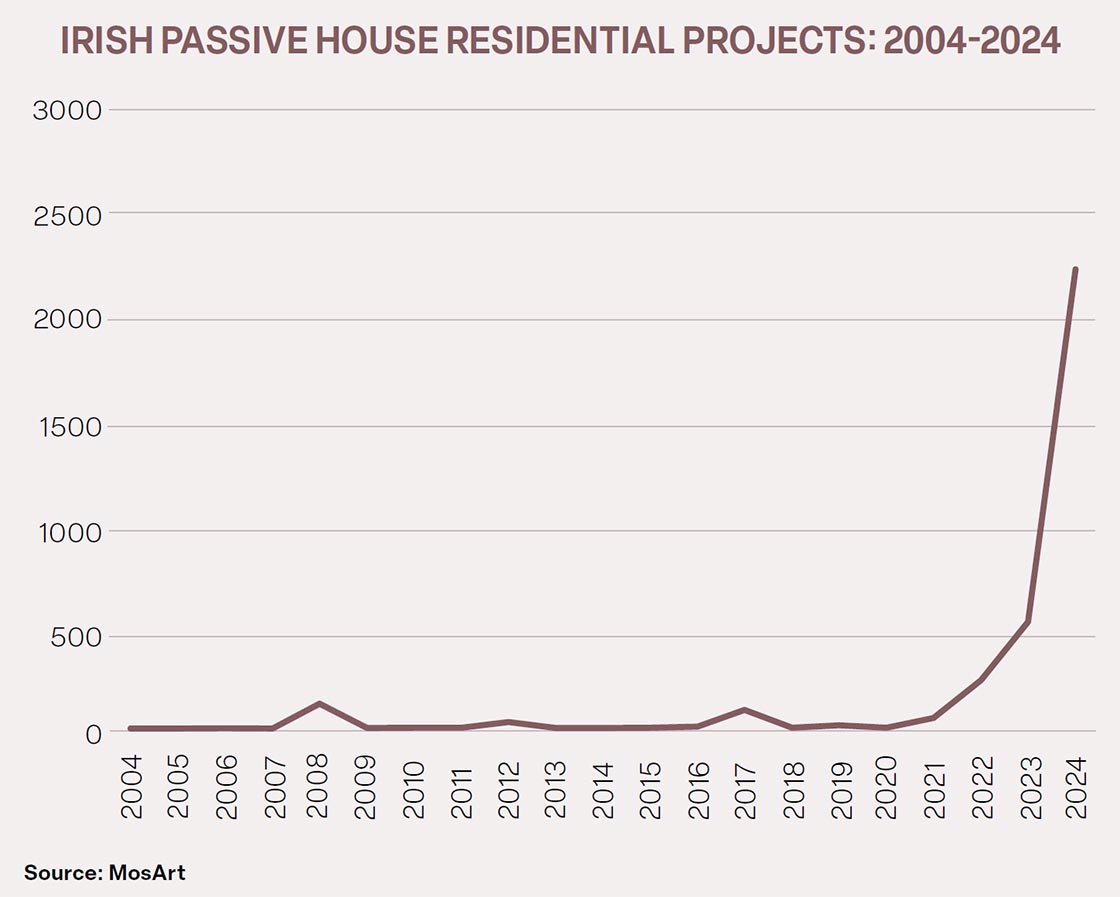
Stephen O’Shea says Cairn took great comfort in MosArt’s long track record in passive house. “Having someone with Tomás’s breadth and depth of experience was absolutely key,” he says. “Knowing that he had been a member of the team that delivered the tallest passive house building in the world really gave us comfort that he had been there, done that, and he was very open to embracing a developer mindset. He knew that was key to making any largescale.
More reassuring still was the fact that MosArt were working on Shanganagh Castle, a social and affordable homes currently approaching completion which includes 546 passive apartments.
Developed by Dún Laoghaire-Rathdown County Council and the Land Development Agency, the project will be the enduring legacy of the passive house clause in Dún Laoghaire Rathdown’s 2016 County Development Plan, which this magazine helped to push through.
“Shanganagh was a huge influence for us,” says Stephen O’Shea. “It answered the ‘Can this be done at scale in Ireland with Irish supply chains?’ question, and now we just had to decide how it could best be done for Cairn. We wanted to use our own methodology, which is very different from the precast solution being used there.
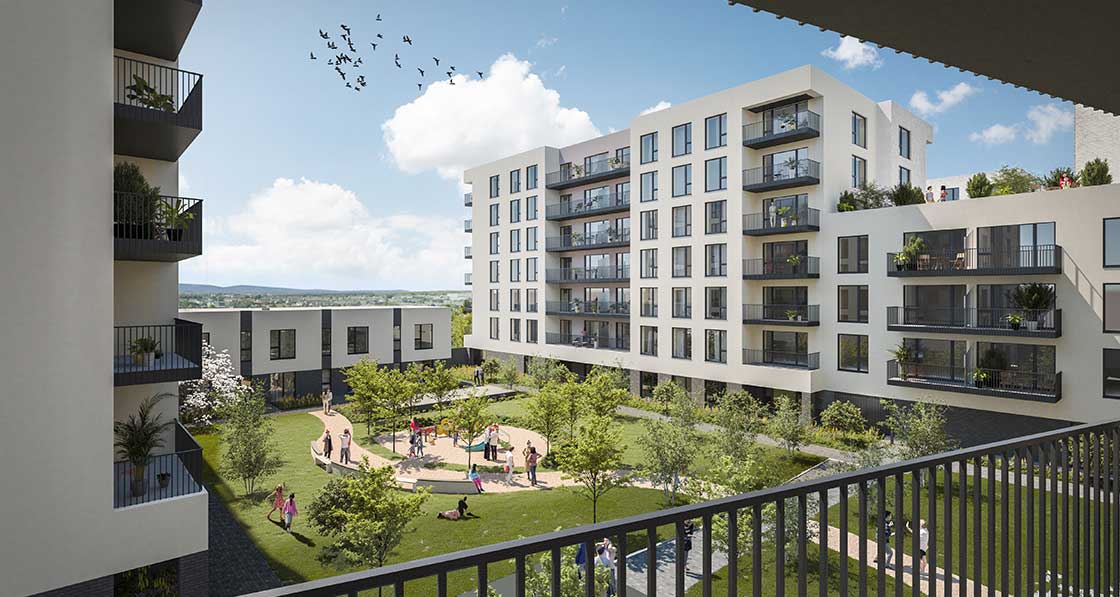
Rendering of Pipers Square Charlestown
Stressing Cairn’s “openness to innovation and a trust in data”, O’Shea paints a picture of a company culture which encourages new ideas to be sought out, aired, discussed and fleshed out. “Through our Innovation Forum we were able to give the idea time and space to be considered and thoroughly researched,” he says.
“What we found is that the benefits were considerable, and the difficulties were not insurmountable.
Passive house had struggled with the image of being too difficult, too bespoke. But when we really examined the changes that would be required to our standard methodology, we found that they weren’t seismic.”
By happenstance or design, feasibility studies showed that Cairn’s quality assurance focus and approach to meeting the nearly zero energy building (NZEB) standard required under Irish building regulations made passive house surprisingly attainable. The apartment buildings needed no extra insulation, though Cairn’s house types needed extra floor and roof insulation, and all buildings would require triple glazing.
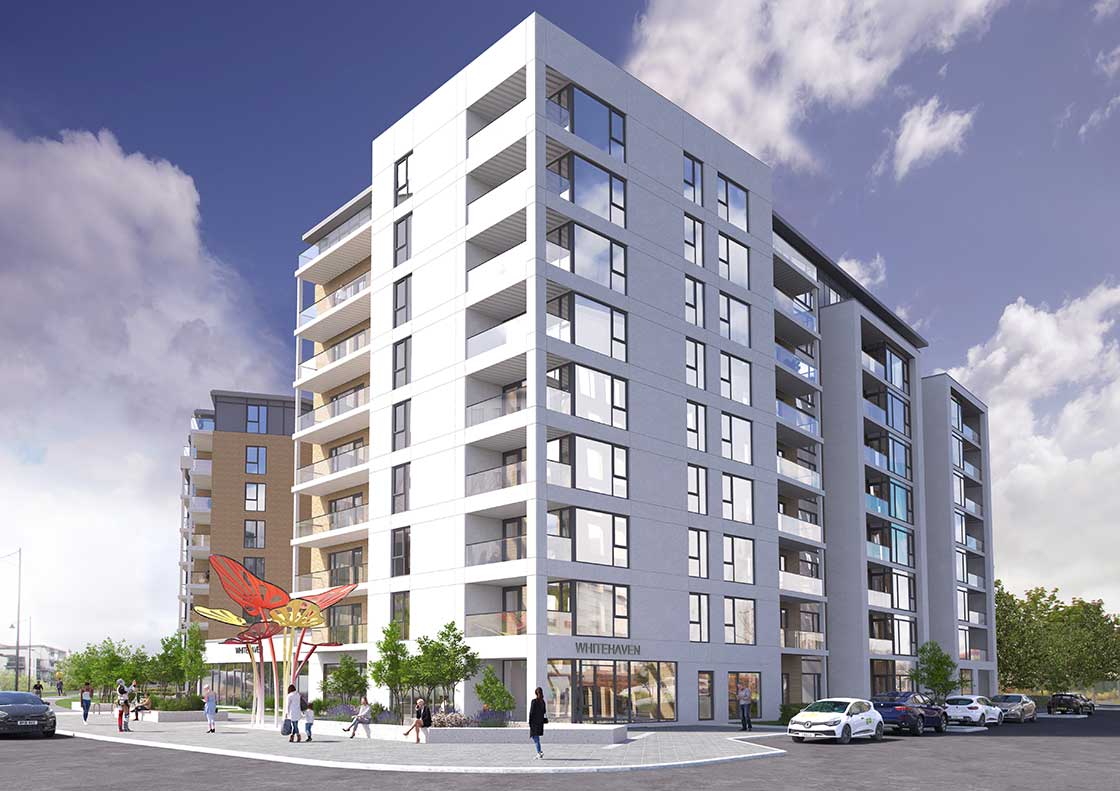
Rendering of Whitehaven Santry
Passive house has the image of being too difficult. But the changes required to our standard methodology weren’t seismic.
The company was already using mechanical ventilation with heat recovery (MVHR) on some and the lower heating demand enabled a switch to a simpler, lower capital cost heating package: direct electric heaters and individual hot water heat pumps.
Following all of this early engagement and the formation by MosArt’s Stephen Donoghue of a study group of developers working on or considering passive house projects, Cairn bit the bullet and took the decision to commit to passive house on the Pipers Square site.
“We acquired Pipers Square with planning permission and started straight into pre-construction,” says Stephen O’Shea. “It was never designed with passive in mind. But the decision was made when we started on pre-construction."
In July 2023, just before Cairn had agreed to push the button on this project, I met O’Shea at an IGBC event in our roles as BuildingLife ambassadors under the World Green Building Council’s BuildingLife Campaign. At this stage there was – quite reasonably – uncertainty from some in the company about stepping into the unknown. O’Shea invited me to come in and give a corporate version of my TEDx talk to Cairn’s senior leadership team (SLT), to help tackle any nagging concerns. I had recently launched a sustainable building comms/strategy business, Zero Ambitions Partners, with my magazine co-founder and podcast co-host Dan Hyde, who used his corporate communications background to help me piece a presentation together. According to Stephen, it made a decisive impact.
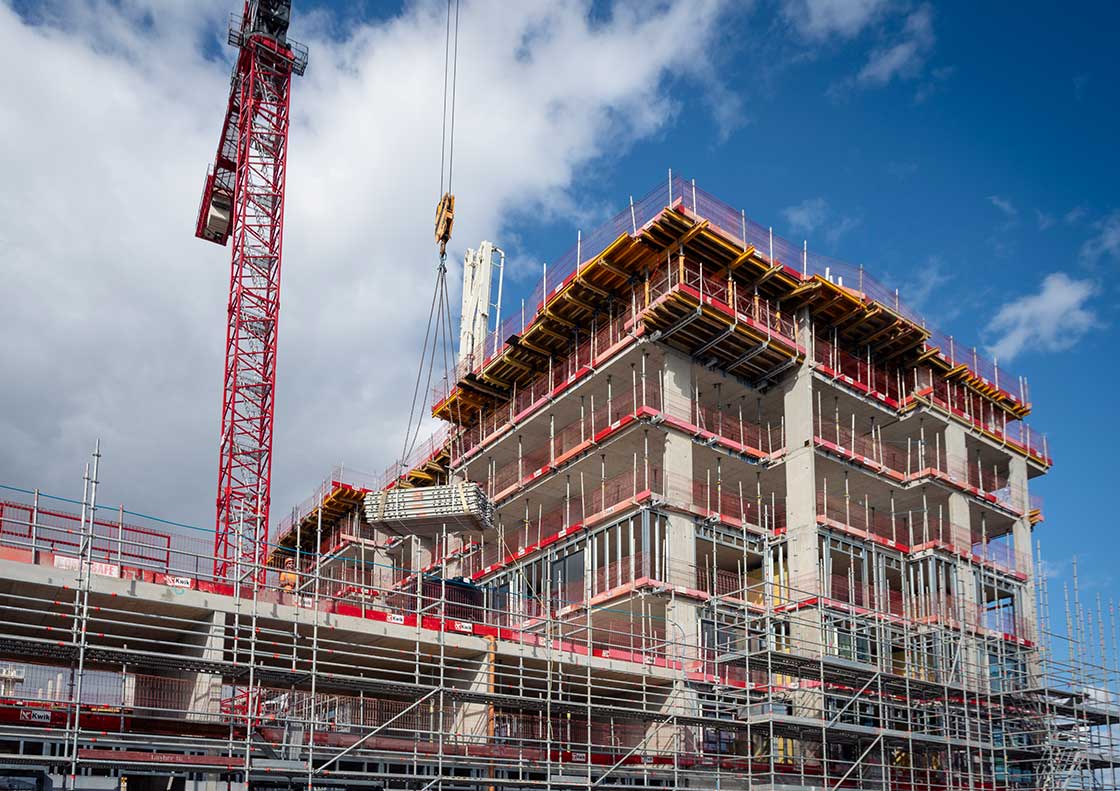
Work progressing on the Pipers Square site in Charlestown
“The change process has been a long one, so even though the strategic decision had been made to go passive for Pipers Square, bringing the SLT and other senior figures together in an open forum was critical,” he says. “We all know the myths around passive house, and we have all felt the fear of trying something new. So having that group addressed by a real subject matter expert who tackled those myths head on was a real turning point.”
My enduring memory of that day was the high level of technical questions coming from Cairn staff in the questions and answers session after my talk – and a clear focus on the customer which went right up to the top of the company, and CEO Michael Stanley.
While the company is implementing a number of decarbonisation strategies, the prospect of better outcomes for customers made passive house stand apart. “Michael Stanley very quickly saw the tangible benefits and added value that it would bring to our customers, and that made a big difference,” says O’Shea.
“Other decarbonisation initiatives such as switching to HVOs for site machinery or using GGBS in concrete mixes don’t have such benefits and can feel somewhat academic as a result, but passive delivers day-after-day, year-afteryear in ways that make real positive differences to people’s lives.”
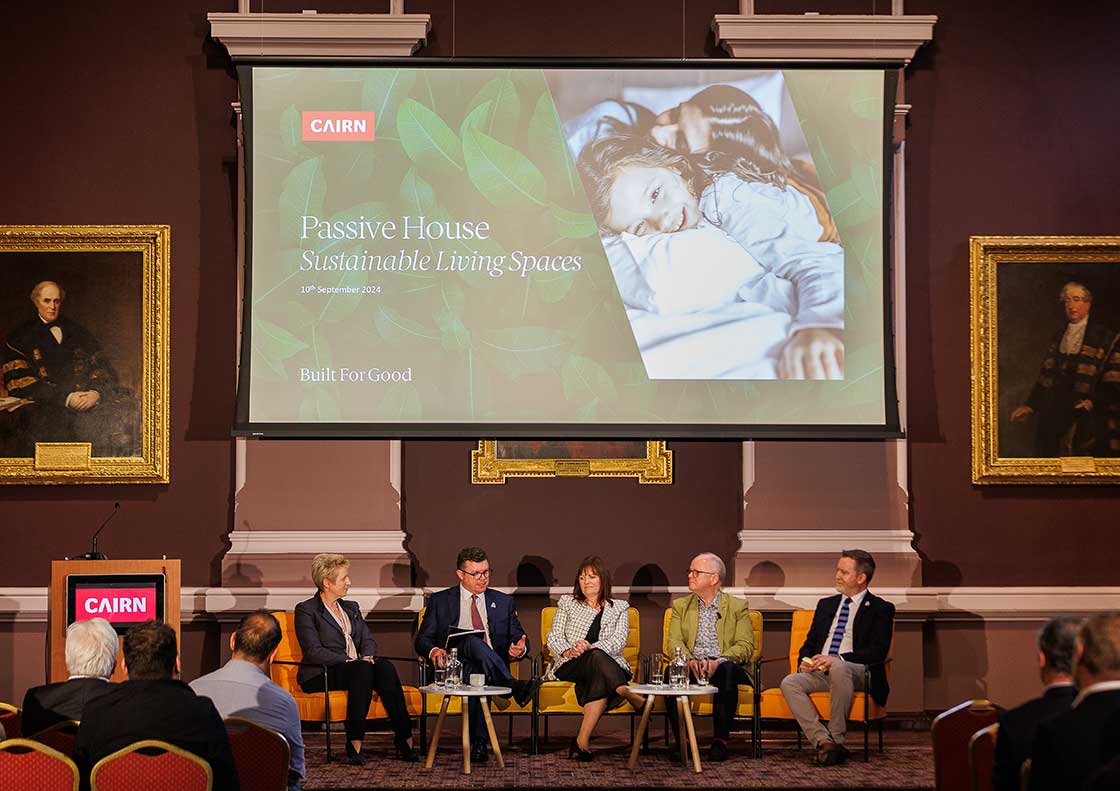
A panel at Cairn's position paper launch including (l-r) Emma Osmundsen, who pioneered large scale passive house projects at Exeter City Council; Cairn construction director Gavin Whelan; Passive House Association of Ireland chair Caroline Ashe Brady; MosArt MD Tomás O'Leary and Cairn's Stephen O'Shea
Virtuous though Cairn’s efforts are, they’re not happening in a vacuum. The business community is coming under exponentially increasing pressure to engage with environmental, social and governance (ESG) investment principles and report on the positive and negative impacts of their activities, including reporting on emissions upstream and downstream of their operations. In the case of a developer, “upstream” means embodied carbon, and “downstream” means sixty years of projected emissions from operational energy use after the buildings are handed over – but all counted in year one in Cairn’s figures. “We measured our carbon footprint in accordance with GHG Protocol and realised how great a proportion of our total – over 50 per cent – comes from the use of the homes we sell.
But while large companies like Cairn are in the first wave of companies subject to the rigours of sustainability reporting obligations under the Corporate Sustainability Reporting Directive (CSRD), O’Shea stresses that the company’s actions are driven by its values, rather than carbon accountancy. “We strive to do the right thing, and then we report on those actions,” he says. “We try to actively avoid letting reporting dictate what we do – it can never be the driving force.”
He does concede, though, that passive house offered an advantage for their reporting. “We were aware that passive house could improve the accuracy of our reporting. We currently apply a substantial ‘penalty’ to our BER data when reporting on our emissions to allow for the performance gap, but if the data was coming from PHPP and the homes were being certified to the passive house standard then we could all but eliminate that safety factor.”
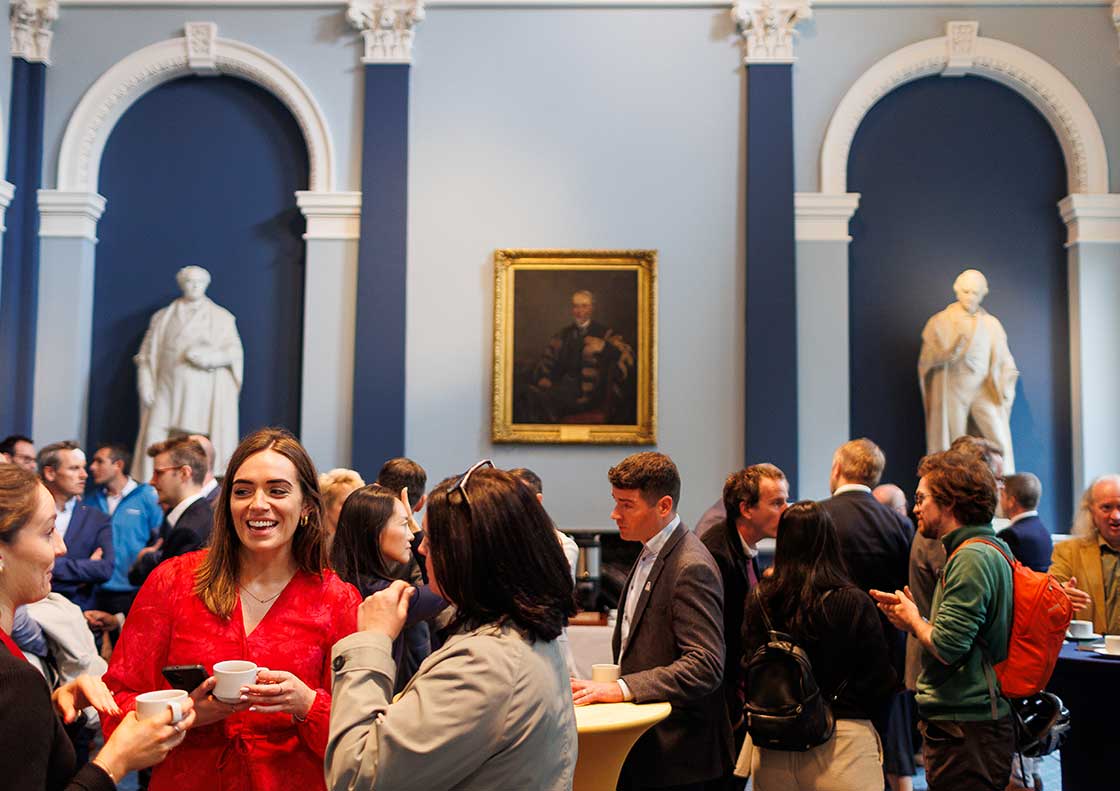
Delegates at the position paper launch event.
Once word got out that we could offer this level of specification and performance, other clients wanted in.
Grand plans are one thing, but putting in place a strategy to actually deliver are quite another. According to Tomás O’Leary, Cairn aren’t taking any chances.
“Cairn are throwing resources at upskilling and educating their staff at various levels,” he says. “They have set quite a few of their senior technical team to do the passive house designer course. We’re currently working on a tailored course for site supervisors.”
With all four sites progressing at a rate of knots, O’Leary is impressed by what he’s seeing. “We’re dealing with their site staff and site supervisors,” he says. “Our experience is that they’re really up for it. You don’t normally get total buy in, but they’ve bought in 100 per cent. They’re all in. Jamie Lacey, a technical manager. The intensity in his eyes – he’s hanging on every word, and he wants to deliver not just passive house but the best passive house in the world. It’s just such a joy to work with people like that.”
While the prospect of meeting passive house is in sight, O’Shea isn’t counting his chickens just yet. “We are now live on four projects, so every day brings new challenges. But our technical teams and consultants are working through them. We’re far from thinking ‘We have this licked’, but very confident that we’ll get there.”
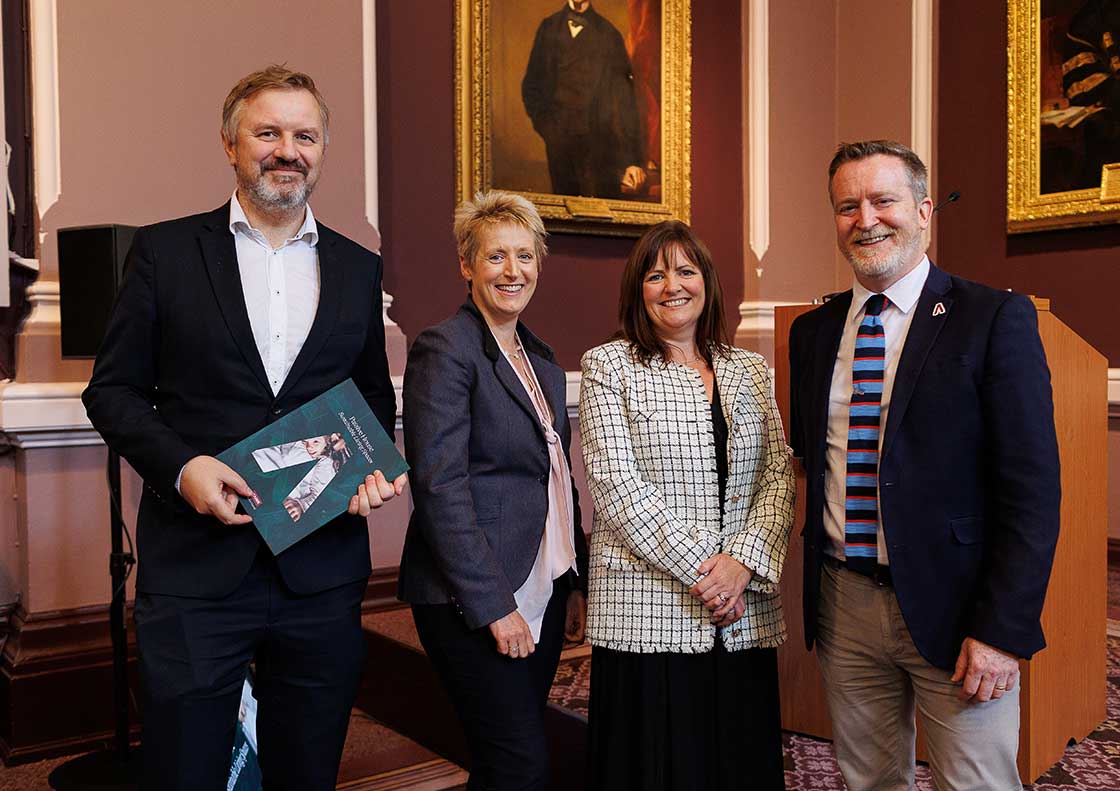
Pictured at the launch are (above, l-r) Passive House Plus editor Jeff Colley, Emma Osmundsen, Caroline Ashe Brady and Stephen O'Shea
The company has absorbed the extra construction costs for going passive on these projects, rather than pass them on to its clients. According to O’Shea, the costs are reasonably low, but a final construction cost hasn’t yet been reached. “Our commercial team are still working through the procurement of all the various packages so we’re not yet at a final figure. And that figure is of course likely to vary from project to project.”
By making a move like this, Cairn is sending a signal far beyond its own team, towards the broader construction industry, that world-class low energy building is viable, attainable and good for business. But how has Cairn’s own supply chain responded so far? “I think it’s fair to say it took some of them by surprise,” says O’Shea. “Some consultants have been quick to embrace the new challenges while others have been less so. But generally speaking, people understand the positives and are willing to do their bit to ensure it happens.”
The passive house standard does place more exacting demands on everyone from designers, to consultants, to site managers, to tradespeople, to product suppliers, and Cairn are not underestimating what that means, and are putting supports in place to ease the transition.
“Everyone is going to be challenged by the change,” says O’Shea. “Some people are enthused by that type of challenge while others may be more fearful, but we are designing bespoke training programmes so that each function and person is taught what they will need to know to deliver successfully. The learning curve will be very steep at the start as we have thrown ourselves in at the deep end, but we’re already seeing the learnings from one project being brought to the next so it shouldn’t take us long to get more comfortable and confident.”
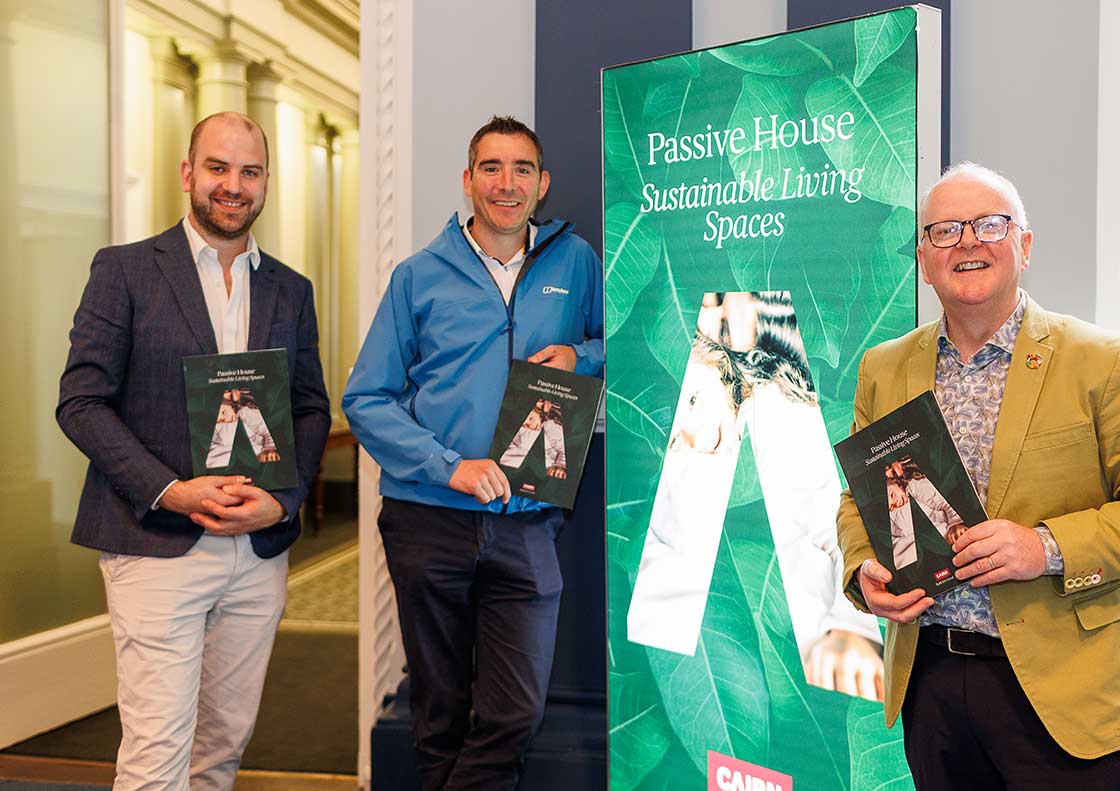
MosArt's marketing manager Denis Manzke, director of innovation and growth Stephen Donoghue and Tomas O'Leary.
But what about the client? The prospect of low carbon, comfortable, low running cost homes has been “very well received” by the clients for these schemes. “Similar to ourselves, they have sustainability ambitions and targets and the best interests of their residents at heart,” says O’Shea, noting that while these clients hadn’t been asking for such exemplary performance, the existence of high density passive schemes like Cairn’s quartet and Shanganagh Castle may start to redefine client expectations.
“Once word got out that we could offer this level of specification and performance, others wanted in. The LDA are already on site with a passive project, and we know that many clients have ambitious energy efficiency targets, so I think they would have gotten there sooner rather than later. But it is better for all parties that it be approached in a spirit of partnership and with a focus on the benefits it will bring to the residents.”
With any building, the proof in the pudding is in the eating. The passive house standard has existed for over a third of a century, with monitoring studies conducted on thousands of buildings to demonstrate the veracity of its seemingly outlandishly low energy use claims. This gives it an advantage over any Johnny-Come-Lately energy standards such as NZEB or the still-gestating Zero Emissions Building (ZEB) standard. But Cairn aren’t resting on their laurels.
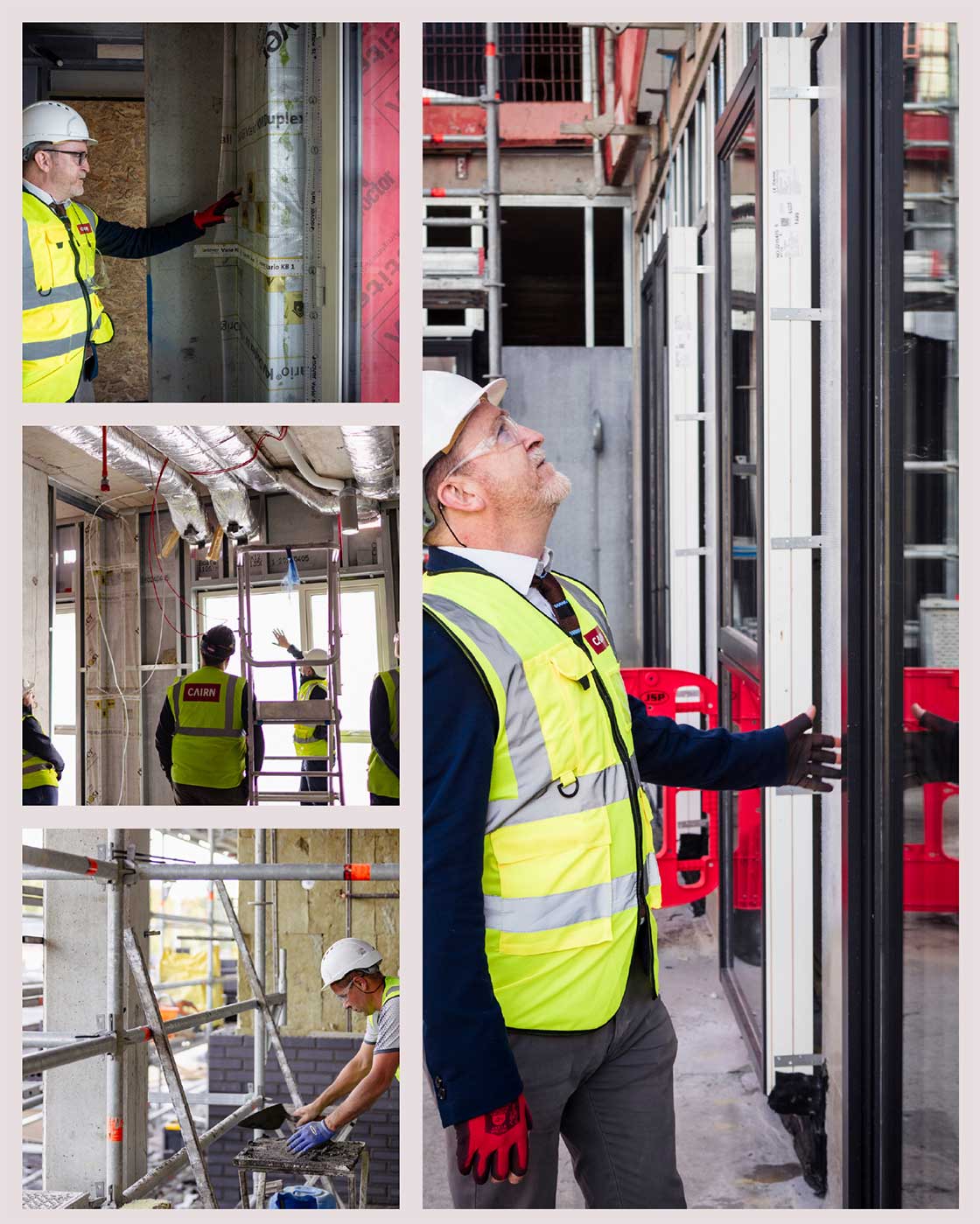
(Clockwise frop top) Stephen O'Shea inspecting works at Pipers Square including the airtight layer; and externally bracketed NorDan Vinduer windows; the mineral wool insulation layer and brick rainscreen; ductwork for the MVHR system.
“We previously partnered with the LDA and University of Galway to carry out a two-year post occupancy evaluation study at an NZEB apartment development we developed in Greystones,” says O’Shea, “with a view to gaining a greater understanding of the performance gap and how occupant behaviour can influence it. We hope to enter a similar partnership with one of the customers for one (or more) of our passive house schemes so we can compare the performance and customer journey.”
Beyond these projects, the company has one eye on the able to pay market. “We would like to pilot a low-density passive house development and see what appetite there might be among private home buyers,” he says, “and then look forward to completing our current projects and following our customers experiences in their world-class homes.”
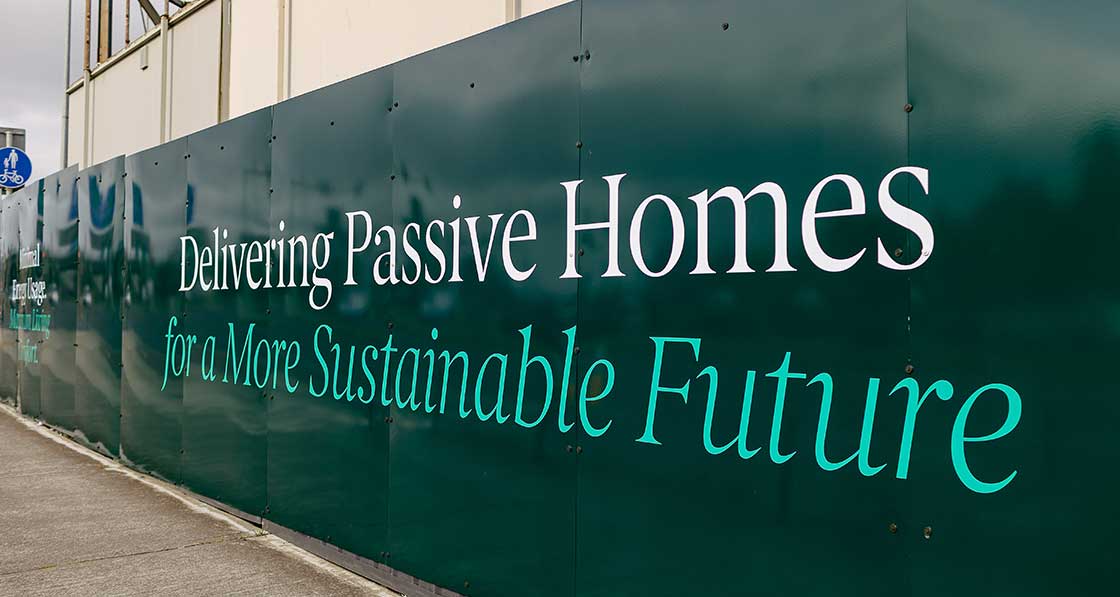
So there you have it. I can still scarcely believe it, but Ireland’s largest home builder has done the unthinkable. Up till now, passive house has too often been the preserve of the enthusiast – the right thing to do, in a sea of people doing wrong or at least questionable things. I’m sure I speak for many people who advocate for passive house when I say that the scale of what Cairn are doing is startling. To mutilate and mutate the words of Oscar Wilde: there is only one thing in life worse than not being listened to, and that is being listened to.
But we must remember the stakes: the world is on fire, the passive house standard is a tried, tested and trustworthy tool to help stop that fire from getting too much hotter while delivering benefits in the here and now for ordinary people, and Cairn’s leadership, without getting too hyperbolic, is the kind of example that proves, just maybe, that unicorns do exist: Big Business Can Do Good Things.
Want to learn more?
To download Cairn’s passive house position paper visit cairnhomes.com/passive-house



